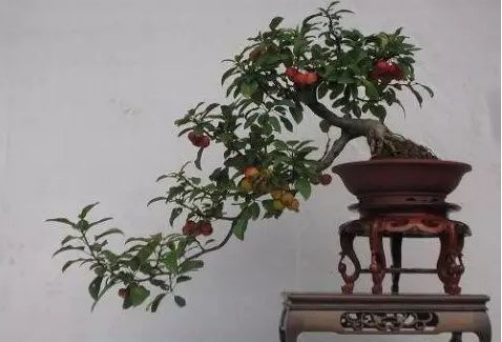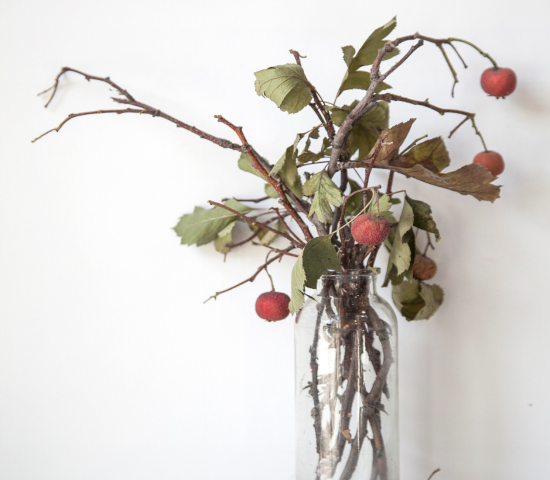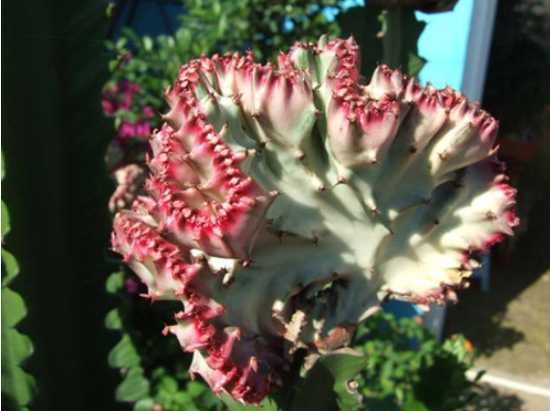Maintenance and management of Hawthorn bonsai
Place
Hawthorn trees like light, lack of sunlight will cause thin branches, thin leaves and light color. So put it in a sunny, well-ventilated place.
Watering
Hawthorn trees are resistant to drought, and the trees that have not yet borne fruit are not strict with the demand for water, but the bonsai after fruit must have an adequate water supply. Ensure that the basin is moist, but do not accumulate water, control the amount of water in autumn and do not let it wet in winter.
Fertilizer application
Hawthorn tree is not particularly fond of fertilizer, apply fertilizer once in winter, should not be too much. Applying phosphorus and potassium fertilizer once after flowering should not be applied with nitrogen fertilizer. Appropriate amount of fertilizer should be applied in autumn.
Protect flowers and fruits
Hawthorn trees in full bloom can be girdled and sprayed with gibberellin.
Pest control
Attention should be paid to the prevention and control of common powdery mildew, red spiders and aphids.

The above is the production method of Hawthorn bonsai, is it much simpler than imagined? I hope the editor's introduction is helpful to you!
Production and maintenance of Hawthorn bonsai Hawthorn, also known as Shanlihong, Hawthorn fruit, is a deciduous shrub or small tree of the genus Hawthorn of Rosaceae. The plant is much branched, the bark is dark brown, the branches are unarmed or less prickly, the leaves are triangular-ovate or rhombic-ovate, the leaves are dark green and glossy, and the edges are sparsely serrated. Corymbose inflorescences, drawn from branch tips or upper leaf axils, florets white, blooming from May to June. The fruit is nearly spherical or oblate, showing crimson or orange or yellow after ripening from September to October, with more light-colored spots. There are many varieties of Hawthorn, and its plant size, leaf shape, size and fruit size are all different. The small fruit is only 0.8 cm in diameter and the large fruit is 3 cm to 4 cm in diameter. Hawthorn used in bonsai should choose those varieties that are small, but vigorous and simple, small leaves, easy to hang fruit, bright fruit color, suitable for potted plants. such as' wild Hawthorn', 'north Hawthorn', 'south Hawthorn', 'Hubei Hawthorn', 'Shandong big gold star', 'gorgeous fruit red', 'Fuli red' and so on. The transplanting of Hawthorn is carried out from defoliation in autumn to sprouting in spring. Because of its few fibrous roots, it should be dipped in mud to keep fresh and moisturizing. Re-cut according to the shape of the tree before planting, cut off the main root, for the excavation time is too long, serious water loss of the stump should be soaked in clear water for a period of time to replenish water. First planted in the sand "billet", planting should be deep, do not show roots, pour water after planting, often spray water to the plant, can also be covered with plastic bags to moisturize. In the first year after the survival of the stump, in addition to the necessary pruning and traction, generally do not do too much modeling, in order to promote the formation of new roots. The following spring moved into the basin, and gradually shaped to cultivate a beautiful crown. The shape of Hawthorn bonsai can be processed into big tree type, upright type, cliff type, water-facing type, oblique dry type and other different forms of bonsai according to the shape of tree stump and material potential. Because of its large leaves, the crown is mostly made into a sparse natural type, and consider the natural collocation of crown and branch, leaf and fruit, and the level between branches and branches should not be too dense, in order to show the natural landscape full of branches. The modeling method should be pruned, flat tied and pulled at the same time, in which flat binding and pulling should be carried out in the growing season, because the branches of Hawthorn are hard and brittle, the bending range should not be too large, pruning is mostly carried out in the dormant season, and the germinating power of Hawthorn is strong. Re-cutting can be carried out under the condition of keeping the tree shape graceful. In the process of modeling, the root can be raised gradually to make it hang the root and reveal its claws, so as to improve the ornamental. Hawthorn has strong habits, like sunny and warm and humid environment, slightly resistant to shade, cold, drought and barren, not strict on soil, but grows better in sandy soil with fertile, loose and good drainage and permeability. During the growth period, it was maintained in an outdoor ventilated and transparent place, and the water was watered thoroughly. The mixed liquid fertilizer of phosphorus and nitrogen was applied once or twice from March to April before flowering, and the liquid fertilizer with high content of phosphorus and potassium was applied every 15 days during the fruit growing period. Because of its developed root system and strong germination, it is necessary to pay attention to thinning the branches and leaves that are too dense. For the more prosperous new shoots, they can leave 4 to 6 leaves to pick the heart when they grow to about 20 cm, so as to promote the growth of short branches hanging fruit. Pruning and shaping is carried out during the dormant period, thin and weak branches, over-dense branches and overgrown branches that disturb the shape of the tree are cut off, the sturdy medium and short branches are retained, the overlong branches extending outward are retracted, the rear branches are made strong, and attention is paid to the retraction of the crown, cutting off the upper branches of the crown, retaining the lower branches, and cultivating them into a shorter new crown. Keep away from the wind and the sun in winter, pay attention to soil moisture and replenish water in time. Turn the pot every other year in spring or autumn to improve its fruit hanging rate. How should Hawthorn bonsai be maintained and made? Hawthorn is generally planted as a fruit tree. in fact, Hawthorn can also be used as an ornamental fruit plant. Hawthorn, also known as Hawthorn, Hawthorn fruit, is a deciduous shrub or small tree of Rosaceae Hawthorn. The plant is much branched, the bark is dark brown, the branches are unarmed or less prickly, the leaves are triangular-ovate or rhombic-ovate, the leaves are dark green and glossy, and the edges are sparsely serrated. Corymbose inflorescences, drawn from branch tips or upper leaf axils, florets white, blooming from May to June. The fruit is nearly spherical or oblate, showing crimson or orange or yellow after ripening from September to October, with more light-colored spots. There are many varieties of Hawthorn, and its plant size, leaf shape, size and fruit size are all different. The small fruit is only 0.8 cm in diameter and the large fruit is 3 cm to 4 cm in diameter. Hawthorn used in bonsai should choose those varieties that are small, but vigorous and simple, small leaves, easy to hang fruit, bright fruit color, suitable for potted plants. such as' wild Hawthorn', 'north Hawthorn', 'south Hawthorn', 'Hubei Hawthorn', 'Shandong big gold star', 'gorgeous fruit red', 'Fuli red' and so on. The transplanting of Hawthorn is carried out from defoliation in autumn to sprouting in spring. Because of its few fibrous roots, it should be dipped in mud to keep fresh and moisturizing. Re-cut according to the shape of the tree before planting, cut off the main root, for the excavation time is too long, serious water loss of the stump should be soaked in clear water for a period of time to replenish water. First planted in the sand "billet", planting should be deep, do not show roots, pour water after planting, often spray water to the plant, can also be covered with plastic bags to moisturize. In the first year after the survival of the stump, in addition to the necessary pruning and traction, generally do not do too much modeling, in order to promote the formation of new roots. The following spring moved into the basin, and gradually shaped to cultivate a beautiful crown. The shape of Hawthorn bonsai can be processed into big tree type, upright type, cliff type, water-facing type, oblique dry type and other different forms of bonsai according to the shape of tree stump and material potential. Because of its large leaves, the crown is mostly made into a sparse natural type, and consider the natural collocation of crown and branch, leaf and fruit, and the level between branches and branches should not be too dense, in order to show the natural landscape full of branches. The modeling method should be pruned, flat tied and pulled at the same time, in which flat binding and pulling should be carried out in the growing season, because the branches of Hawthorn are hard and brittle, the bending range should not be too large, pruning is mostly carried out in the dormant season, and the germinating power of Hawthorn is strong. Re-cutting can be carried out under the condition of keeping the tree shape graceful. In the process of modeling, the root can be raised gradually to make it hang the root and reveal its claws, so as to improve the ornamental. Hawthorn has strong habits, like sunny and warm and humid environment, slightly resistant to shade, cold, drought and barren, not strict on soil, but grows better in sandy soil with fertile, loose and good drainage and permeability. During the growth period, it was maintained in an outdoor ventilated and transparent place, and the water was watered thoroughly. The mixed liquid fertilizer of phosphorus and nitrogen was applied once or twice from March to April before flowering, and the liquid fertilizer with high content of phosphorus and potassium was applied every 15 days during the fruit growing period. Because of its developed root system and strong germination, it is necessary to pay attention to thinning the branches and leaves that are too dense. For the more prosperous new shoots, they can leave 4 to 6 leaves to pick the heart when they grow to about 20 cm, so as to promote the growth of short branches hanging fruit. Pruning and shaping is carried out during the dormant period, thin and weak branches, over-dense branches and overgrown branches that disturb the shape of the tree are cut off, the sturdy medium and short branches are retained, the overlong branches extending outward are retracted, the rear branches are made strong, and attention is paid to the retraction of the crown, cutting off the upper branches of the crown, retaining the lower branches, and cultivating them into a shorter new crown. Keep away from the wind and the sun in winter, pay attention to soil moisture and replenish water in time. Turn the pot every other year in spring or autumn to improve its fruit hanging rate.
- Prev

Ornamental value of Hawthorn bonsai
Cultivated Hawthorn bonsai has a high ornamental value, its shape is like all kinds of living animals, some like rock climbing monkeys, some like mighty lions, some like funny squirrels, some very interesting, and some very much like welcome pines. Strong branches look like strong warriors.
- Next

Points for attention in Golden Kirin Culture:
First, pay attention to timely pruning and pruning branches that are too long and too dense, so as to promote more branches of the golden unicorn. If it is not pruned, the plant shape of the golden unicorn is not beautiful and the number of flowers will be reduced. Timely pruning will make the golden unicorn blossom and branch more. Second, change the basin in time. Kirin had better change the basin once every 1-2 years.
Related
- Fuxing push coffee new agricultural production and marketing class: lack of small-scale processing plants
- Jujube rice field leisure farm deep ploughing Yilan for five years to create a space for organic food and play
- Nongyu Farm-A trial of organic papaya for brave women with advanced technology
- Four points for attention in the prevention and control of diseases and insect pests of edible fungi
- How to add nutrient solution to Edible Fungi
- Is there any good way to control edible fungus mites?
- Open Inoculation Technology of Edible Fungi
- Is there any clever way to use fertilizer for edible fungus in winter?
- What agents are used to kill the pathogens of edible fungi in the mushroom shed?
- Rapid drying of Edible Fungi

